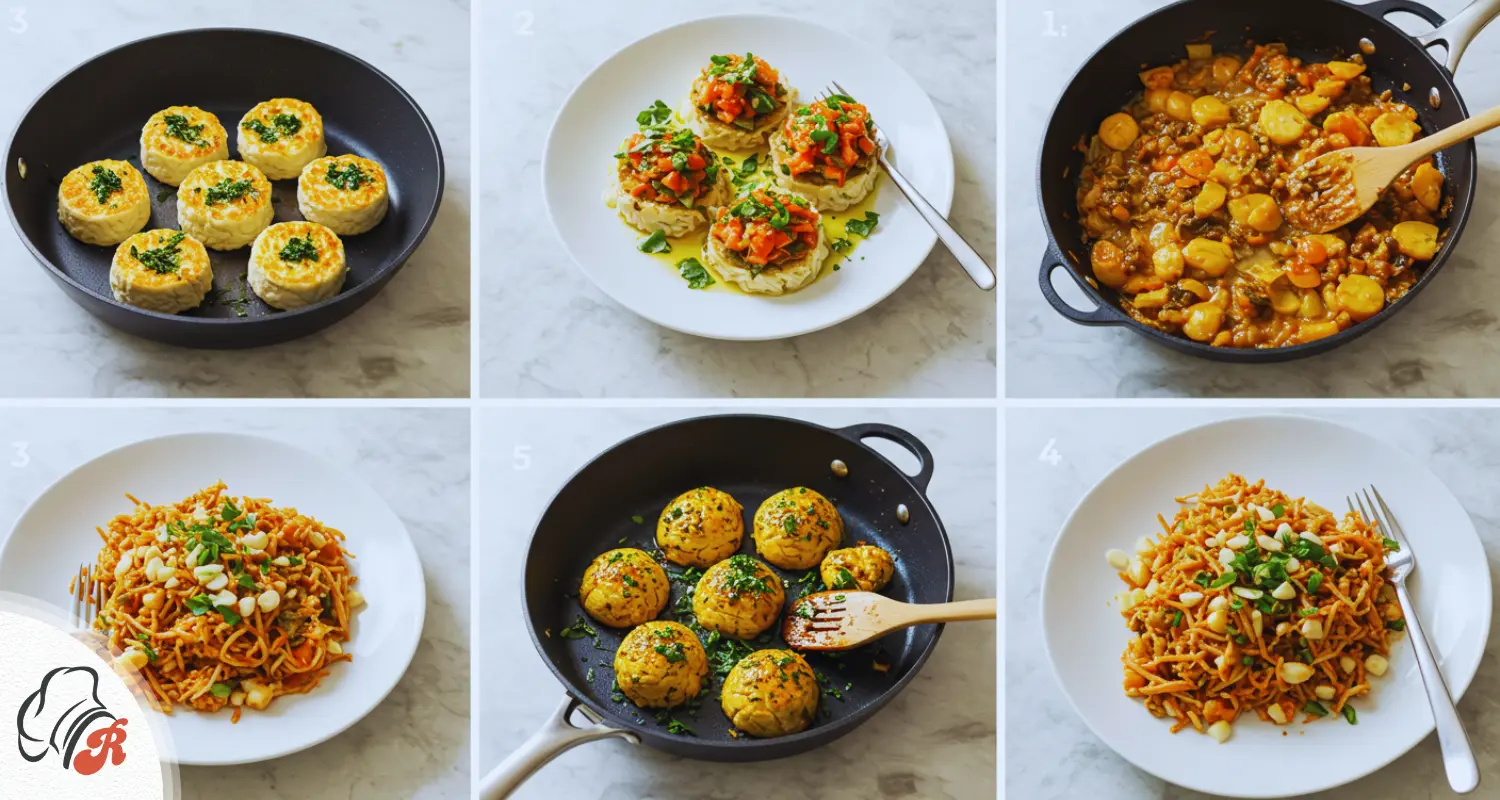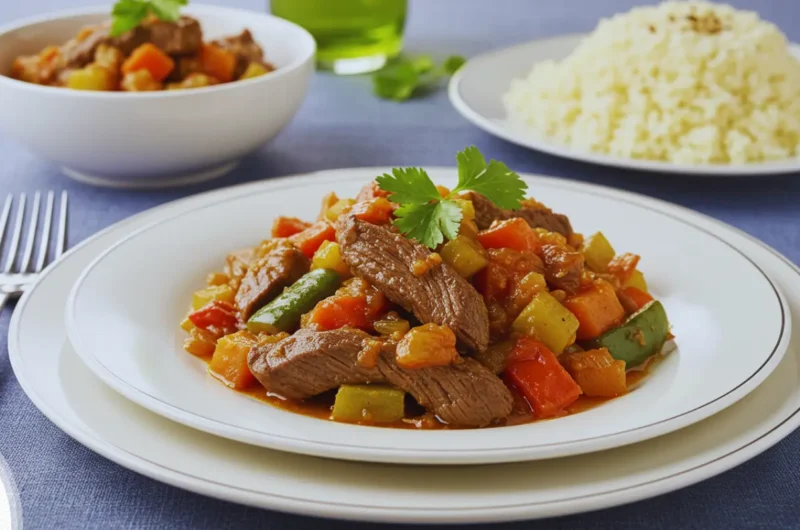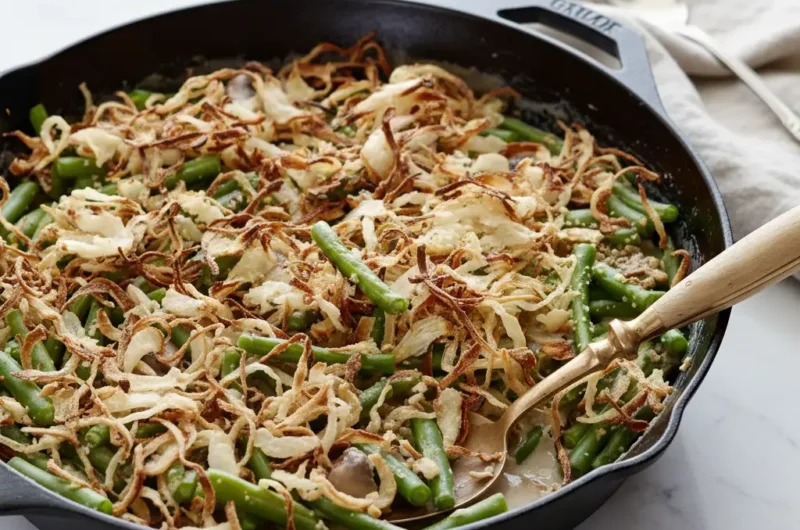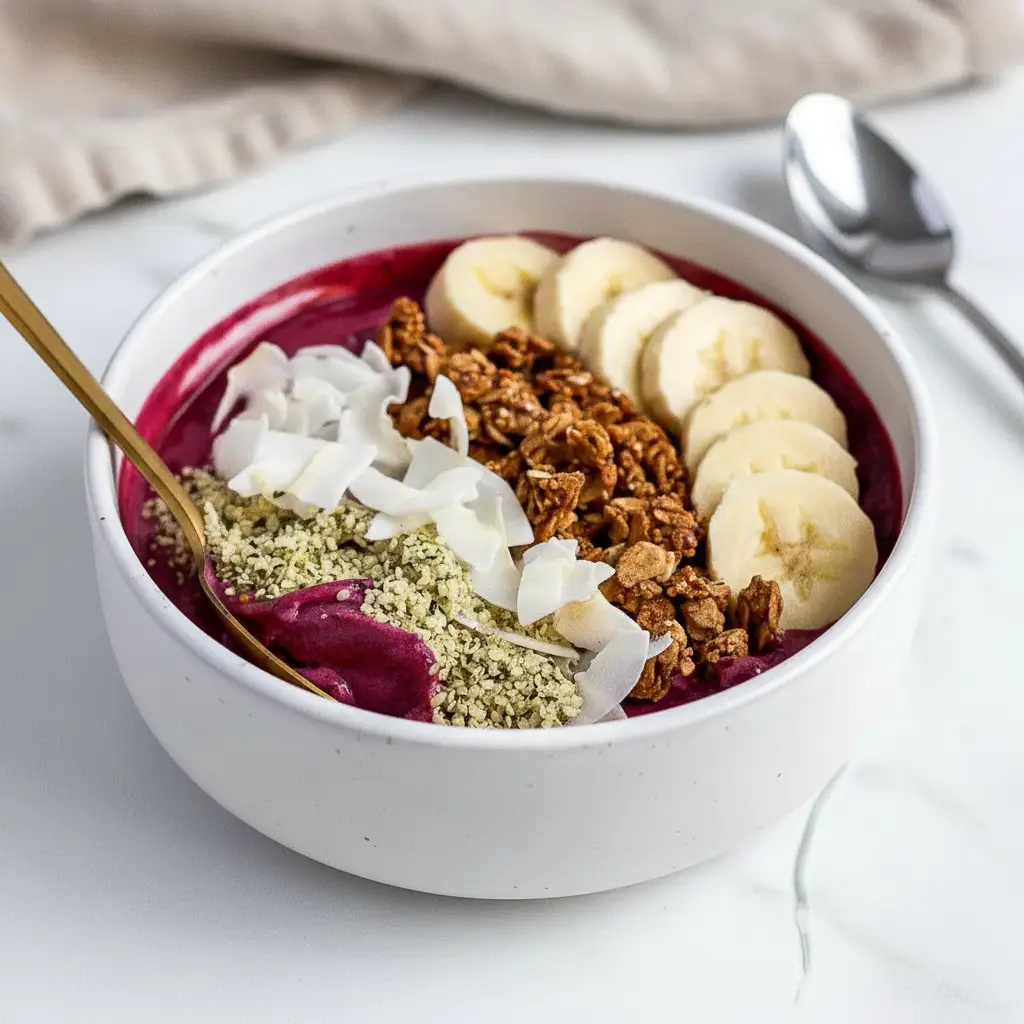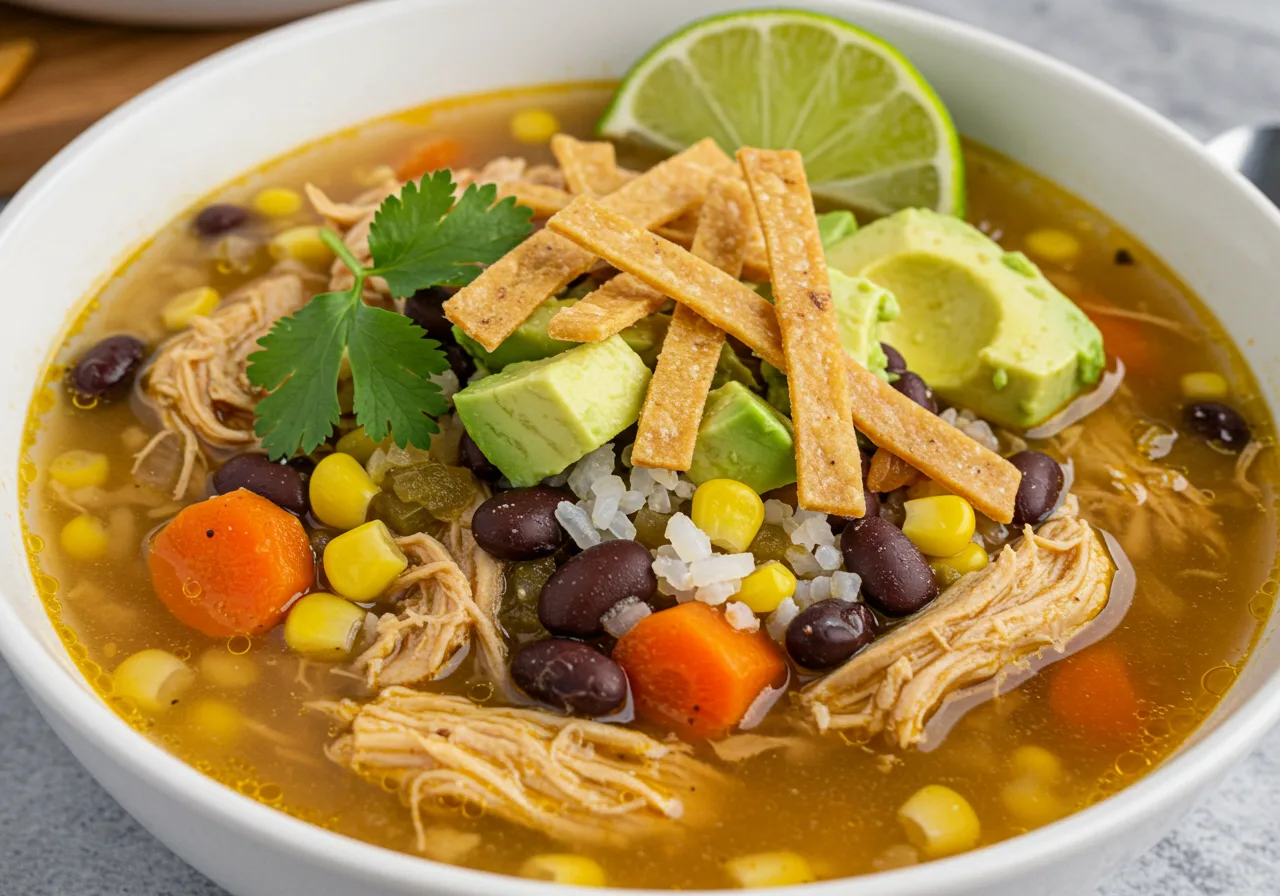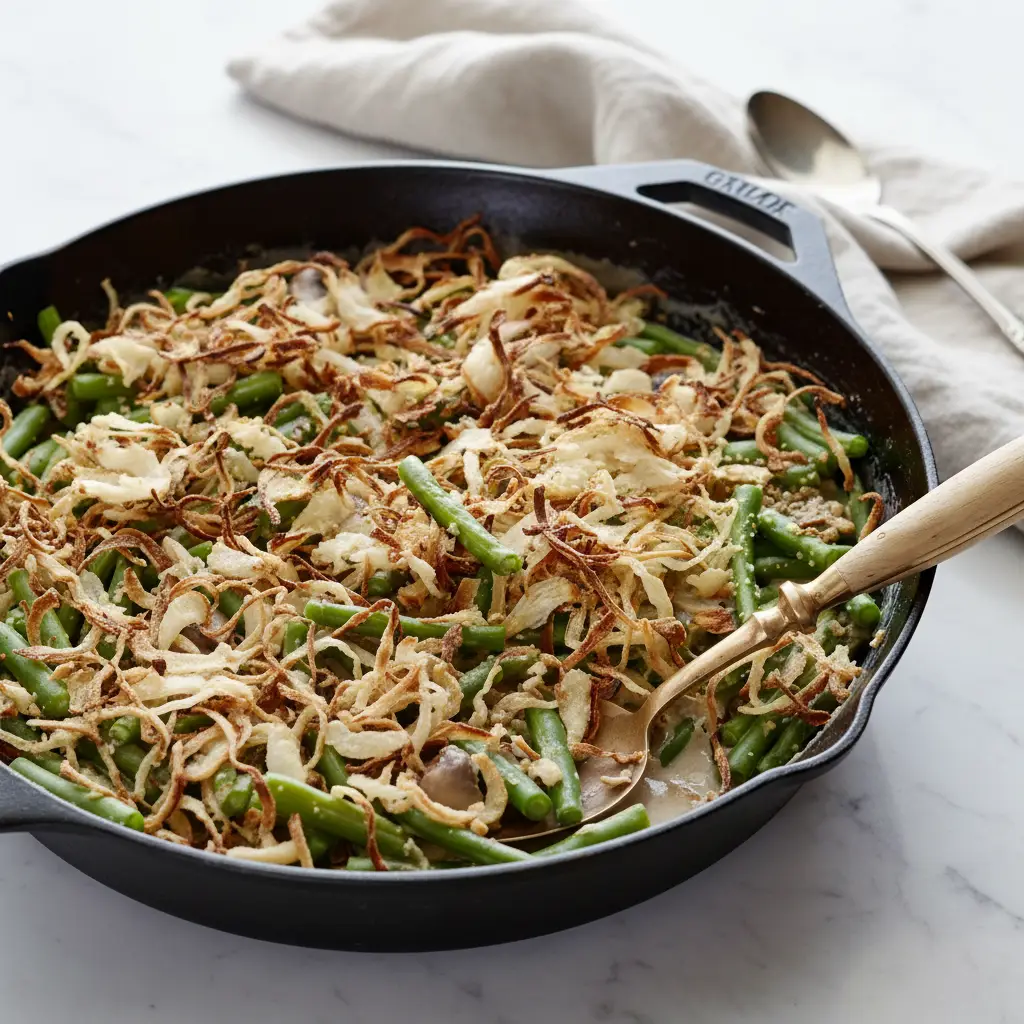If you’re looking to explore the rich flavors of Mediterranean and Middle Eastern cuisine, the Terra Massoud recipe is a must-try dish.
This hearty, aromatic meal is a perfect blend of tender proteins, vibrant vegetables, and a medley of spices that will leave your taste buds dancing.
Whether you’re a seasoned cook or a beginner in the kitchen, this recipe is easy to follow and highly customizable to suit various dietary preferences.
Terra Massoud Recipe
Course: Main Course, LunchCuisine: Middle EasternDifficulty: Medium4
servings20
minutes45
minutes350
kcal1
hour5
minutesA flavorful Middle Eastern dish made with a rich blend of spices, vegetables, and meat, served with rice or bread.
Ingredients
1 lb lamb or beef, cubed
2 tablespoons olive oil
1 large onion, chopped
3 cloves garlic, minced
1 teaspoon ground cumin
1 teaspoon ground coriander
1 teaspoon ground cinnamon
1/2 teaspoon ground turmeric
1/2 teaspoon ground paprika
1 cup chopped tomatoes
1 cup beef or vegetable broth
Salt and pepper to taste
Fresh parsley for garnish
Directions
- In a large pot, heat olive oil over medium heat.
- Add onions and garlic, sauté until softened.
- Add the cubed meat, browning on all sides.
- Stir in the spices and cook for 2 minutes until fragrant.
- Add tomatoes, broth, salt, and pepper. Bring to a boil, then reduce heat to low.
- Simmer for 35-40 minutes, or until the meat is tender.
- Garnish with fresh parsley and serve with rice or bread.
Notes
- You can substitute lamb with beef or chicken if desired.
Adjust the spice level to taste by adding more or less paprika and cumin.
Serve with a side of yogurt or a fresh salad for a complete meal.
Table of Contents
What is Terra Massoud Recipe?
Terra Massoud is a flavorful and aromatic dish that originates from the heart of Mediterranean and Middle Eastern cuisines. It has long been a staple in various countries known for their rich culinary traditions.
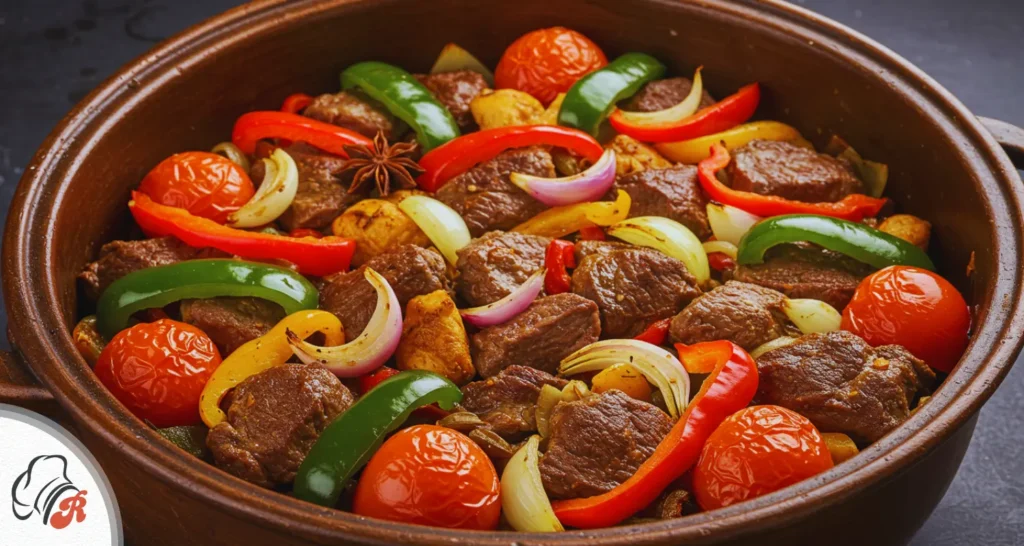
Definition and Origin
The name “Terra Massoud” refers to a specific combination of ingredients, often blending fresh herbs, spices, and proteins, to create a balanced, savory meal. While it might vary slightly by region or personal preference, the essence of the dish remains the same—celebrating fresh ingredients and bold flavors.
Some food historians trace the dish back to ancient Middle Eastern trade routes, where spices like cumin, coriander, and sumac became essential in local kitchens. Over time, Terra Massoud recipe has evolved, becoming popular for its simplicity and versatility. It is widely enjoyed in countries like Lebanon, Syria, Turkey, and parts of North Africa.
Traditional Ingredients
At the heart of Terra Massoud lies a combination of fresh, wholesome ingredients that define its unique flavor. Commonly, it includes:
- Proteins: Lamb, chicken, or beef are often the primary protein sources in Terra Massoud recipe. Some variations also use fish or plant-based proteins like chickpeas for a vegetarian take.
- Vegetables: Earthy vegetables like tomatoes, onions, and bell peppers are commonly used in the dish. These vegetables provide a natural sweetness and juiciness that balance the savory flavors.
- Herbs and Spices: The dish is heavily seasoned with a variety of Mediterranean and Middle Eastern spices. Common spices include cumin, coriander, paprika, cinnamon, and turmeric. Fresh herbs like parsley, mint, and cilantro are also used to garnish and elevate the flavor profile.
- Acidity: Ingredients like lemon or vinegar are often added to bring a refreshing acidity that cuts through the richness of the dish, making it even more flavorful.
Flavor Profile
Terra Massoud recipe is known for its balance of rich, bold, and fresh flavors. The savory depth of meats or vegetables combines with the brightness of fresh herbs and the heat from spices, offering a complex yet comforting taste. The acidity of lemon or vinegar helps to lift the dish, making each bite satisfying without being overwhelming.
Depending on the specific recipe or regional variation, the flavor profile can lean more on the spicy side with chili peppers or focus on a more herbal and earthy taste with an abundance of cilantro or parsley. It’s this versatility that makes Terra Massoud such a beloved dish across cultures.
Cultural Significance
In addition to being a delicious dish, Terra Massoud holds cultural significance in the Mediterranean and Middle Eastern communities. It’s often prepared during special occasions or as a family meal, bringing people together over shared food. The use of seasonal ingredients also reflects the region’s emphasis on eating locally and sustainably. For many, Terra Massoud recipe is more than just a meal—it’s a symbol of hospitality, family, and tradition.
This expanded section provides a more in-depth look at the definition, origins, ingredients, and cultural importance of Terra Massoud, giving readers a fuller understanding of the dish before diving into the recipe itself.
Essential Ingredients for Terra Massoud
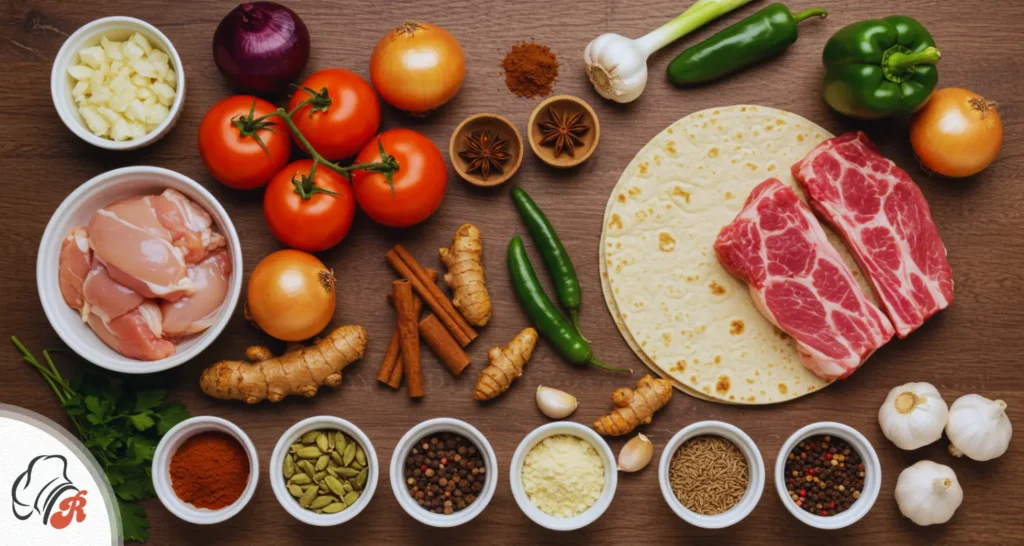
Terra Massoud is a dish built on the harmony of fresh ingredients, bold spices, and simple yet flavorful components. Each ingredient plays a vital role in contributing to the dish’s signature taste and texture. Whether you’re preparing a classic version or experimenting with variations, here’s an in-depth look at the essential ingredients that define Terra Massoud:
Herbs and Spices: The Heart of Flavor
A key feature of Terra Massoud is its use of aromatic herbs and spices that bring vibrancy and depth to the dish. These ingredients not only enhance the flavor but also give it an authentic Mediterranean or Middle Eastern feel. Some of the most common and essential herbs and spices include:
- Cumin: Known for its warm, earthy flavor with a subtle hint of citrus, cumin is one of the most important spices in Terra Massoud recipe. It helps to bring out the richness of the meats and vegetables, creating a well-rounded base flavor.
- Coriander: Ground coriander adds a slightly sweet, citrusy note that balances the heat from other spices. Its versatility in the dish helps create a layer of freshness, complementing the richness of the other ingredients.
- Paprika: Often used to provide a mild heat and smoky flavor, paprika enhances the depth of the dish while adding a touch of color to the final presentation. Sweet or smoked paprika can be used, depending on your preference.
- Cinnamon: While it may seem unconventional, cinnamon provides a delicate warmth and depth to Terra Massoud. It adds a hint of sweetness that contrasts beautifully with the savory elements.
- Turmeric: Known for its golden color and slightly bitter flavor, turmeric brings a distinct earthiness to Terra Massoud and helps balance the dish’s overall flavor profile.
- Fresh Herbs (Parsley, Mint, Cilantro): Fresh herbs are typically used to garnish Terra Massoud, adding a burst of freshness. Parsley is the most common, but mint and cilantro are often used to provide additional aromatic layers and a touch of brightness.
Main Ingredients: The Base of the Dish
Terra Massoud’s foundation is built on the use of key ingredients, which vary depending on the specific version or regional variation of the dish. These ingredients provide the substance and structure for the recipe:
- Proteins: Terra Massoud is a flexible dish that can be made with a variety of proteins. The most common choices are lamb, chicken, or beef, which provide a rich, meaty flavor that complements the spices. Each protein adds its unique texture and taste to the dish. In vegetarian versions, chickpeas, lentils, or other plant-based proteins can be substituted to provide similar richness.
- Vegetables: Terra Massoud recipe typically incorporates a combination of hearty vegetables such as tomatoes, onions, bell peppers, and eggplants. These vegetables contribute both flavor and texture, with tomatoes providing juiciness and sweetness, onions adding depth and umami, and peppers offering a touch of smokiness. Depending on the region or personal preference, additional vegetables like zucchini, carrots, or potatoes can also be included.
- Rice or Grains: In some versions of Terra Massoud, rice or grains like bulgur or couscous are included to serve as the base of the dish, helping to absorb the flavors and create a more filling meal. The grains are often seasoned with the same spices as the main dish, allowing them to soak up the rich flavors and become an integral part of the meal.
Acidity: Balancing the Richness
Acidic ingredients are used to provide balance and brighten up the rich, savory flavors of Terra Massoud. The most common acidic additions include:
- Lemon: Fresh lemon juice or lemon zest is commonly added to Terra Massoud to give the dish a refreshing tang. The acidity cuts through the richness of the meats and enhances the overall flavor profile, making it taste lighter and more vibrant.
- Vinegar: In some variations, a splash of vinegar (often red wine or apple cider vinegar) is added to bring a more subtle, tangy note to the dish. It adds a touch of sharpness and helps round out the overall flavor.
Fat: For Richness and Moisture
A moderate amount of fat is often used in Terra Massoud to ensure the dish remains moist and flavorful, enhancing both the texture and mouthfeel. Common sources of fat include:
- Olive oil: A staple in Mediterranean cooking, olive oil is used both for sautéing vegetables and for drizzling over the finished dish. It imparts a fruity richness and complements the herbs and spices beautifully.
- Ghee or Butter: For a more luxurious mouthfeel, some versions of Terra Massoud include ghee (clarified butter) or regular butter. This adds a rich, creamy element that helps bind the flavors together and elevates the overall dish.
Sweeteners: A Hint of Sweetness
In some regional variations of Terra Massoud, a small amount of sweetness is introduced to balance the savory and spicy elements of the dish. This could come from:
- Raisins or dried apricots: These dried fruits add a natural sweetness and chewy texture that contrast wonderfully with the savory and spicy components.
- Honey: A drizzle of honey or a sprinkle of sugar might be added to bring a touch of sweetness that enhances the earthy flavors, especially if the dish is made with lamb or chicken.
Optional Additions
While these ingredients form the backbone of Terra Massoud recipe, the beauty of the dish lies in its versatility. Additional components, such as:
- Nuts: Toasted pine nuts or slivered almonds may be sprinkled on top to add crunch and richness.
- Yogurt: A dollop of tangy yogurt or a drizzle of tahini sauce can be served on the side to add creaminess and a cool contrast to the warmth of the dish.
Step-by-Step Instructions for the Perfect Terra Massoud
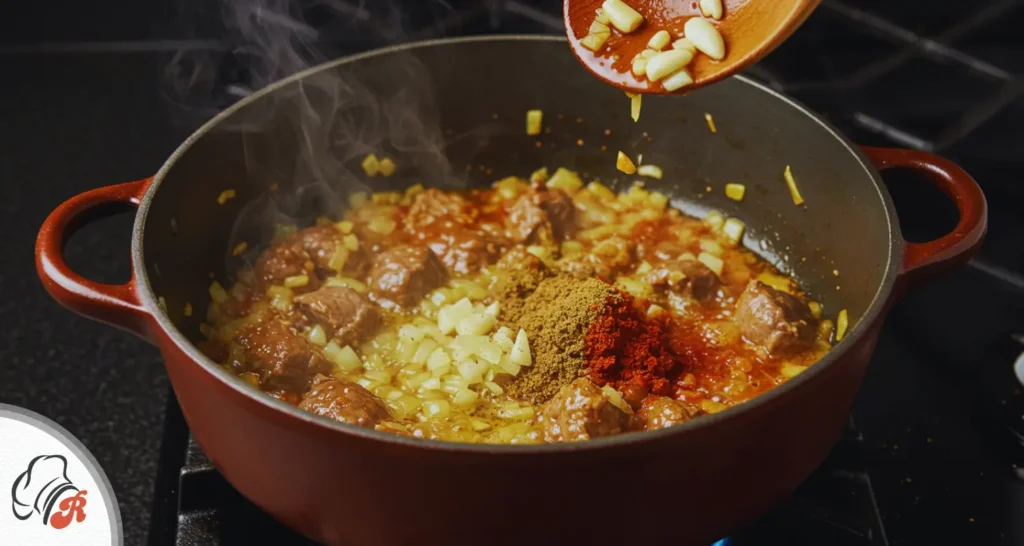
Creating the perfect Terra Massoud involves layering flavors, balancing spices, and ensuring the ingredients are cooked to perfection. While the recipe can be adapted to suit personal preferences or dietary restrictions, these general step-by-step instructions will guide you through preparing an authentic and delicious Terra Massoud recipe, whether you’re using meat, vegetables, or a combination of both.
Step 1: Prepare the Ingredients
Before you begin cooking, it’s important to have all your ingredients prepped and ready to go.
- Proteins: If using lamb, chicken, or beef, cut the meat into bite-sized pieces. Season with a pinch of salt, pepper, and a bit of cumin and paprika to infuse the protein with flavor.
- Vegetables: Dice tomatoes, onions, and bell peppers. If using eggplants, zucchini, or potatoes, peel (if desired) and chop them into cubes. Ensure your vegetables are uniform in size for even cooking.
- Herbs and Spices: Measure out the spices like cumin, coriander, cinnamon, turmeric, and paprika. Chop fresh herbs such as parsley, mint, and cilantro for garnishing. If you’re using garlic, mince it finely.
- Acidity and Liquids: Have your lemon ready for juicing and vinegar or wine (if using) for adding some acidity to balance the richness of the dish. You may also want to have stock or water on hand for cooking.
Step 2: Sauté the Aromatics
To start building depth in the dish, heat a generous amount of olive oil or ghee in a large skillet or Dutch oven over medium heat. This is where you’ll develop a flavorful base.
- Onions and Garlic: Add the chopped onions and sauté them until they become soft and translucent (about 5 minutes). Combine the minced garlic and cook for 1–2 minutes, until it releases its scent.
- Spices: Once the onions and garlic are fragrant, add the ground spices—cumin, coriander, paprika, turmeric, and cinnamon. Stir constantly to toast the spices, which will release their essential oils and enhance the flavor of the dish. Be careful not to burn them, as this can make the spices bitter.
Step 3: Brown the Meat (If Using)
If you’re making a meat-based Terra Massoud, the next step is to brown the protein to lock in its flavor.
- Browning the Protein: Increase the heat to medium-high and add your choice of protein (chicken, lamb, beef, or other). Allow the meat to sear for about 5–7 minutes, turning it occasionally, until it forms a golden-brown crust on all sides. This step caramelizes the natural sugars in the meat, intensifying its flavor. If you’re using a vegetarian version, you can skip this step and move on to the vegetables.
Step 4: Add Vegetables and Simmer
Once the meat is browned, it’s time to add the vegetables, which will help balance the richness of the protein and infuse the dish with fresh, savory flavors.
- Vegetables: Add your diced tomatoes, bell peppers, and any other vegetables you’re using (such as eggplants, zucchini, or carrots). Stir them into the meat and cook for about 5 minutes until the vegetables soften.
- Liquid: Pour in a bit of stock, water, or wine to help create a savory sauce. You’ll want enough liquid to cover the bottom of the pan but not submerge the ingredients completely. This will allow the vegetables to cook evenly while preserving the concentrated flavors.
- Simmer: Lower the heat and cover the pan. Let the ingredients simmer gently for 15–20 minutes, stirring occasionally. This will allow the flavors to meld together, and the vegetables will become tender while releasing their natural juices. If you’re using chickpeas, lentils, or another vegetarian protein, add them at this stage as well.
Step 5: Season and Add Acidity
Once the vegetables are tender and the protein is cooked through, it’s time to adjust the seasoning and add the final touches to bring everything together.
- Flavoring: Sample the dish and modify the flavoring as needed. Add more salt, pepper, or spices (such as extra cumin or paprika) if needed to ensure the flavor is well-balanced.
- Acidity: To bring brightness and balance the richness of the dish, add a squeeze of fresh lemon juice. Alternatively, you can use vinegar or pomegranate molasses to achieve the same effect. These acidic ingredients help cut through the savory flavors and make the dish feel lighter and more vibrant.
Step 6: Cook the Grains (Optional)
If you’re serving Terra Massoud recipe with rice, couscous, or bulgur, it’s time to prepare your base.
- Cooking Rice or Grains: Cook the rice or grains according to the package instructions, adding a pinch of salt and a dash of olive oil for extra flavor. For a more flavorful rice, you can cook it with some of the spices used in the Terra Massoud (such as cumin or turmeric), or even stir in some sautéed onions and garlic.
Step 7: Garnish and Serve
Once the Terra Massoud has simmered and the flavors have had time to meld, it’s time to plate the dish.
- Garnish: Sprinkle freshly chopped herbs such as parsley, cilantro, and mint over the top of the dish for a burst of color and freshness. You can also sprinkle some toasted pine nuts or slivered almonds for added texture and richness.
- Serving Suggestions: Serve the Terra Massoud over a bed of rice, couscous, or alongside warm pita bread. A dollop of yogurt or tahini sauce on the side can help cool the dish and add creaminess.
Step 8: Enjoy!
Once plated, gather your family or friends around and enjoy the incredible flavors of your homemade Terra Massoud recipe. The combination of rich, savory flavors, tender proteins, and fresh herbs makes this dish a true crowd-pleaser.
Tips for Making Terra Massoud Recipe Even Better
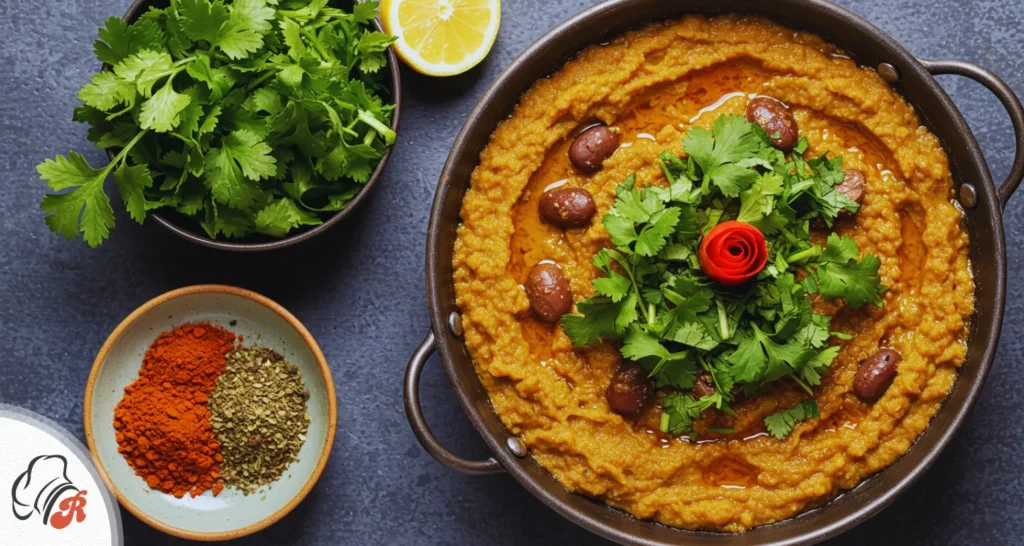
While Terra Massoud is already a delicious and satisfying dish on its own, there are several tips and tricks that can elevate your version to the next level. Whether you’re looking to enhance the flavor, improve the texture, or give the dish a unique twist, these tips will help ensure your Terra Massoud turns out perfectly every time.
1. Customize the Recipe to Your Taste
One of the beautiful things about Terra Massoud is its versatility. You can tweak the recipe to suit your personal preferences or dietary restrictions.
- Protein Variations: While lamb, chicken, and beef are traditional choices, don’t be afraid to experiment with other proteins. If you prefer a leaner option, try turkey or fish. For a completely plant-based version, you can use chickpeas, lentils, or even tofu for a rich, hearty texture.
- Vegetable Choices: Terra Massoud is flexible when it comes to vegetables. While tomatoes, onions, and bell peppers are common, you can easily swap or add other seasonal vegetables. Try eggplant, zucchini, or sweet potatoes for extra flavor and texture. Roasted carrots or butternut squash also work beautifully in this dish.
- Spice Adjustments: The beauty of Terra Massoud recipe lies in its aromatic spices, but you can adjust the spice levels to suit your taste. If you prefer a milder flavor, reduce the amount of chili or paprika. For a more intense and bold dish, increase the amount of cumin, coriander, or cinnamon.
2. Don’t Skip the Browning Step
Browning the meat (or vegetarian protein) is crucial for developing deep, rich flavors. The Maillard reaction, which occurs when meat is browned, intensifies the savory taste and creates a wonderful caramelized crust on the protein.
- Even Browning: Ensure that the pieces of meat are spaced out in the pan and not overcrowded, as overcrowding will steam the meat rather than sear it. If necessary, brown the meat in batches to ensure each piece gets a nice, golden-brown crust.
- Rest the Meat: Once browned, let the meat rest for a couple of minutes before continuing to cook it. This allows the juices to redistribute and results in a more tender, flavorful dish.
3. Layer the Spices Slowly and Thoughtfully
To achieve the best flavor, it’s essential to toast the spices before adding the liquids. This method extracts the essential oils from the spices and brings out their full potential.
- Toast the Spices: After sautéing the onions and garlic, add the ground spices (cumin, coriander, paprika, cinnamon, etc.) and cook them in the hot oil for about 30 seconds to 1 minute. Stir constantly to prevent burning. This step deepens the flavor of the spices and makes the dish more aromatic.
- Don’t Overdo It with Spices: While Terra Massoud is all about bold flavors, be mindful of how much spice you add. The goal is to create a well-balanced dish. Start with a smaller amount of spice and adjust to taste as you go.
4. Use Homemade or High-Quality Stock
If you’re adding liquid to the dish—whether it’s stock, water, or wine—using homemade stock or high-quality store-bought stock can elevate the flavor significantly.
- Rich Flavor: Homemade chicken or vegetable stock brings more depth and complexity to the dish. If using store-bought, opt for a low-sodium version to avoid overwhelming the flavors with too much salt.
- Wine for Depth: If you’re using wine as part of the cooking liquid, red wine pairs beautifully with lamb or beef, while white wine is excellent with chicken or fish. The wine adds richness and a slight acidity, balancing out the dish’s flavors.
5. Don’t Overcook the Vegetables
Vegetables in Terra Massoud recipe should remain tender but not mushy. Overcooking vegetables can result in a loss of flavor and texture, which detracts from the dish’s overall appeal.
- Add Vegetables at the Right Time: Add vegetables like bell peppers, tomatoes, and eggplant after the meat is browned and the spices have been toasted. This gives them enough time to cook through and soften but not disintegrate into the sauce.
- Keep the Vegetables’ Color and Texture: When cooking, try to maintain the vegetables’ natural color and texture. Vegetables like bell peppers should retain some bite and should not turn into a mushy stew. A light simmering time of 15-20 minutes is usually sufficient.
6. Make the Grains Flavorful
If you’re serving Terra Massoud with rice, couscous, or bulgur, make sure the grains are seasoned well to complement the rich flavors of the dish.
- Season the Cooking Liquid: When cooking your rice or couscous, add a pinch of salt and a dash of olive oil to the water. For extra flavor, you can also cook the grains with a bay leaf, cinnamon stick, or a splash of stock.
- Herbs and Spices: Stir in some of the same spices used in the Terra Massoud (like cumin or turmeric) to flavor the grains. You can also sprinkle some fresh chopped herbs, like parsley or cilantro, over the grains once they are cooked to add a fresh note.
7. Don’t Forget the Garnishes
Garnishing is an important step in making your Terra Massoud visually appealing and adding that final burst of flavor and freshness.
- Fresh Herbs: A generous sprinkle of fresh cilantro, parsley, or mint will brighten up the dish and provide a refreshing contrast to the rich, savory flavors. The freshness of the herbs balances the richness of the meat and spices.
- Toasted Nuts: Consider adding toasted pine nuts or slivered almonds on top for an added crunch. These nuts not only enhance the texture but also add a mild sweetness that complements the dish beautifully.
- Yogurt or Tahini Sauce: A dollop of creamy yogurt or a drizzle of tahini sauce on the side can provide a cool contrast to the warm, spiced dish. The creaminess helps mellow out the intensity of the spices while adding a rich, tangy element.
8. Let It Rest Before Serving
Like many stews and braised dishes, Terra Massoud tastes even better the next day. If you have the time, let the dish rest for at least 30 minutes after cooking. This resting period allows the flavors to meld and develop even more, making the dish richer and more aromatic.
- Make Ahead: Terra Massoud can also be prepared a day in advance and reheated before serving. The resting time allows the ingredients to soak in the spices, making the dish more flavorful.
9. Serve with Complementary Side Dishes
To round out the meal, serve your Terra Massoud with complementary side dishes that enhance the overall experience.
- Pita Bread: Soft, warm pita bread is perfect for scooping up the dish and absorbing the flavorful sauce.
- Simple Salad: A refreshing cucumber and tomato salad with a lemony vinaigrette can offer a bright contrast to the rich and hearty Terra Massoud.
- Pickled Vegetables: A side of tangy pickled vegetables (like pickled cucumbers or turnips) can help cut through the richness of the dish and provide a flavorful palate cleanser.
Why Terra Massoud Recipe is a Must-Try Dish
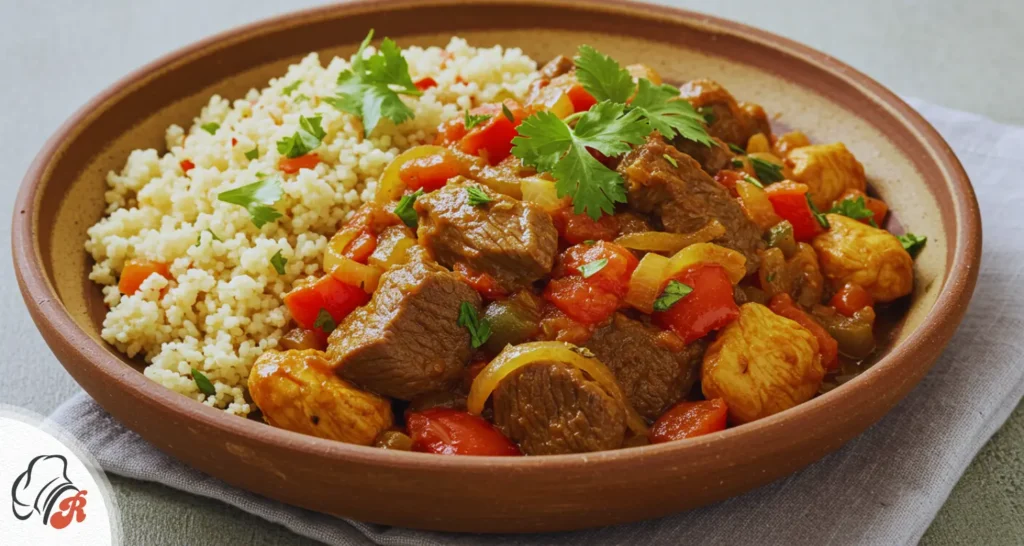
Terra Massoud is a standout dish for anyone looking to experience the rich flavors of Mediterranean and Middle Eastern cuisine. With its vibrant combination of spices, fresh ingredients, and cultural significance, this dish offers far more than just a satisfying meal. Here’s why Terra Massoud is a must-try dish for food lovers of all backgrounds:
1. Rich in Flavor and Aroma
One of the main reasons Terra Massoud is so beloved is its complex and aromatic flavor profile. The careful combination of spices like cumin, coriander, cinnamon, and paprika brings a unique warmth and depth to the dish. Whether it’s the savory richness of the protein or the burst of freshness from herbs like parsley, cilantro, and mint, every bite of Terra Massoud is an explosion of flavors. The slow simmering process allows the spices to fully infuse the dish, creating a tantalizing aroma that draws people in. It’s a dish that fills the house with an irresistible fragrance, making it hard to wait for the first bite.
2. Nutritionally Balanced and Wholesome
Terra Massoud isn’t just delicious—it’s also nutritionally balanced, making it a great option for a wholesome meal. The dish typically includes a combination of protein, vegetables, and grains, ensuring you get a variety of essential nutrients in every serving. The protein (whether it’s lamb, chicken, or chickpeas) provides the necessary amino acids, while the vegetables add fiber, vitamins, and minerals. The spices offer additional health benefits, as many of them—such as turmeric and cinnamon—are known for their anti-inflammatory properties. With its focus on fresh ingredients and wholesome components, Terra Massoud is a satisfying and nourishing meal that will leave you feeling energized.
- Protein: The meats in Terra Massoud provide a rich source of protein, essential for muscle growth, repair, and overall health.
- Vegetables: Packed with fiber, vitamins, and antioxidants, the vegetables in the dish contribute to digestive health, immune support, and overall vitality.
- Spices: Many of the spices used in Terra Massoud recipe, like cumin and coriander, are rich in antioxidants and have been linked to various health benefits, including anti-inflammatory effects and digestive support.
3. Flexible and Adaptable for Different Diets
One of the most appealing aspects of Terra Massoud is its versatility. Whether you’re a meat eater, a vegetarian, or following a specific diet, Terra Massoud can easily be customized to suit your needs. You can opt for:
- Meat-based versions: Traditional Terra Massoud is made with lamb, chicken, or beef, providing a hearty and flavorful meal.
- Vegetarian or vegan options: Chickpeas, lentils, or tofu can replace the meat, making the dish just as satisfying while catering to plant-based diets.
- Gluten-free: Since Terra Massoud often includes rice or couscous as a base, it can easily be adapted to be gluten-free by choosing gluten-free grains or skipping them altogether.
This adaptability makes Terra Massoud recipe an inclusive dish that can be enjoyed by everyone, regardless of dietary preferences.
4. A Perfect Meal for Entertaining
Whether you’re hosting a family dinner or preparing a meal for friends, Terra Massoud is a crowd-pleaser that’s sure to impress. The dish has an elegant presentation with vibrant colors from the vegetables, fresh herbs, and spices, making it visually appealing as well as delicious. Serving a dish like Terra Massoud not only showcases your culinary skills but also introduces your guests to a beautiful and flavorful part of Mediterranean and Middle Eastern cuisine.
- Family-friendly: With its hearty ingredients and rich flavors, Terra Massoud is perfect for families, offering a comforting and filling meal that appeals to both adults and children.
- Easy to share: The dish is often served in a large communal platter, making it ideal for sharing. It’s a great way to bring people together around the table to enjoy a meal and create lasting memories.
5. Deeply Rooted in Tradition and Culture
Terra Massoud isn’t just a dish; it’s a reflection of the rich culinary heritage of the Mediterranean and Middle Eastern regions. It carries centuries of tradition and history, representing the art of balancing fresh ingredients, spices, and cooking techniques. By preparing and enjoying Terra Massoud, you’re not only indulging in a delicious meal but also connecting with the culture and history of the regions where this dish originated.
- Cultural Connection: The dish is often prepared for special occasions, family gatherings, and celebrations, which gives it a deeper cultural significance. For many people in the Mediterranean and Middle Eastern regions, making Terra Massoud is a way of honoring their ancestors and continuing a long-standing culinary tradition.
- Seasonal Ingredients: Terra Massoud is often made using fresh, seasonal ingredients, which reflects the region’s focus on eating locally and sustainably. This connection to the earth and seasonality makes the dish a true celebration of the land.
6. Quick and Easy to Prepare
Despite its complex flavor profile, Terra Massoud recipe is relatively easy to prepare, making it perfect for both novice cooks and seasoned chefs. With a few simple steps—sautéing aromatics, browning the meat, adding vegetables, and simmering—you can create a dish that tastes like it’s been simmering for hours.
- One-pot meal: Terra Massoud can be made in a single pan or pot, which means less cleanup afterward. This makes it a practical option for busy weeknights or casual gatherings.
- Make-ahead option: Terra Massoud is even better the next day, making it a great dish to prepare in advance. You can enjoy leftovers, as the flavors continue to deepen and develop after resting.
7. A Taste of the Mediterranean and Middle Eastern Lifestyle
By trying Terra Massoud, you’re experiencing the essence of Mediterranean and Middle Eastern cuisine. These regions are known for their emphasis on fresh, high-quality ingredients, as well as their relaxed, communal dining experiences. The Mediterranean and Middle Eastern culinary traditions also celebrate the joy of eating and sharing meals with loved ones, and Terra Massoud is no exception.
- Slow food culture: The process of preparing Terra Massoud encourages slow cooking, which allows you to appreciate the layers of flavor that develop over time.
- Sharing and togetherness: In Mediterranean and Middle Eastern cultures, food is often served in large quantities, meant to be shared among friends and family. Enjoying Terra Massoud together fosters a sense of connection and community, making it a great choice for bringing people together.
Terra Massoud is a must-try dish for its rich blend of flavors and unique textures, offering a perfect balance of spices and freshness. Its combination of tender ingredients and aromatic seasonings makes it an unforgettable experience for any food lover. Discover more about Terra Massoud and its cultural significance here.


